Lion850
National Hazard
   
Posts: 514
Registered: 7-10-2019
Location: Australia
Member Is Offline
Mood: Great
|
|
Attempt to make iron iii oxalate
I made ferrous oxalate FeC2O4 quite some time ago, this is a bright yellow powder practically insoluble in water. I read that ferric oxalate
hexahydrate Fe3(C2O4)2.6H2O is a lime green compound slightly soluble in water so I had a go at making some.
- 10g Fe2O3 was added to a beaker with 50g concentrated HCl, with stirring and heating (acid in excess).
- After some time all the oxide was dissolved, into a dark brown solution of presumably ferric chloride.
- Add 24g oxalic acid powder and 10ml water.
- After heating and stirring 3 hours the solution was still brown but the splashes were now light green.
- At this point the beaker stood on the bench with an hour glass on top until I found time to carry one....which was 6 weeks later!
- By now most of the liquid evaporated. I was left with a black and green sludge with some oily black liquid and a strong hydrochloric acid smell.
- I decanted off as much liquid as I could and put the rest on the steam bath for 4 hours. The result was this sticky goop, still smelling of acid:
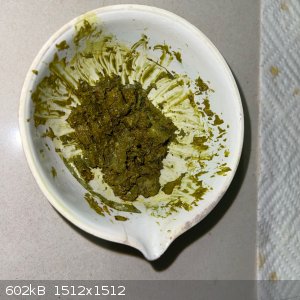
- I planned to stir small samples of the goop with different solvents to see if something breaks it up. I first tried acetone (because I have a lot)
and was pleasantly surprised to see a powdery lime green suspension with the acetone having turned black:
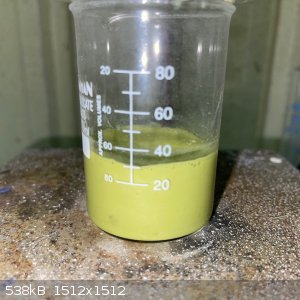
- I then added all to 100ml acetone in a beaker and stirred for some 6 hours (no heating). The contents was then gravity filtered. The filtrate was
black with a lime green remainder. I washed the remainder in the funnel twice with acetone, by which time the run-through was now also light green and
not black anymore. Below shows the washed remainder and the filtrate:
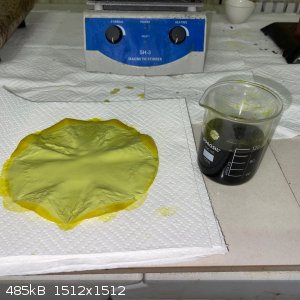
- The remainder was left to air dry for 24 hours. This gave some 11g of pale green colored powder with no smell.
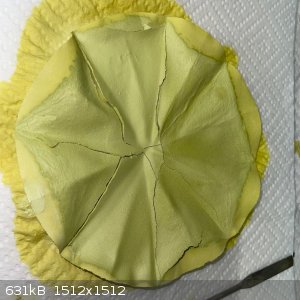 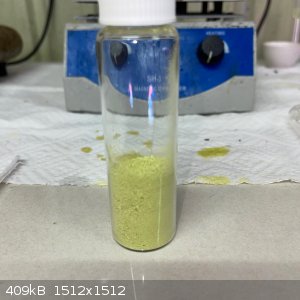
- Below shows the ferrous oxalate I made a few years ago and the ferric oxalate, to show the color difference.
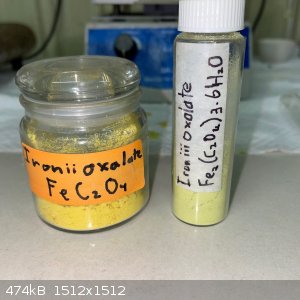
- The only test I did was to shake a bit of each of the two oxalates with water in test tubes and then to let is stand 30 minutes. The yellow ferrous
oxalate all settles out quite quick, while with the more green ferric oxalate the water remains colored, as it should if it is slightly soluble.
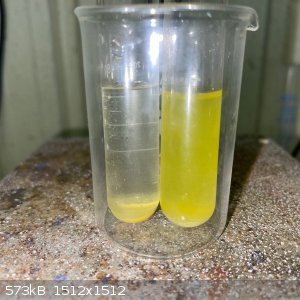
Looking at online images of ferric oxalate the color of my product seems representative.
|
|
|
Amos
International Hazard
    
Posts: 1406
Registered: 25-3-2014
Location: Yes
Member Is Offline
Mood: No
|
|
You could've simply boiled the iron oxide directly with oxalic acid, and filtered out any solids which did not dissolve. You made your work harder by
adding hydrochloric acid! Also a reminder about oxalates if you plan to do more work like this: Dissolved ferric oxalate in solution is readily
degraded by sunlight(I believe with oxidation of the oxalate ion to CO2 by the iron(III) cation) and I imagine this would be the case for some other
oxalates as well. Just a couple of things to think about.
|
|
|
Texium
Administrator
       
Posts: 4508
Registered: 11-1-2014
Location: Salt Lake City
Member Is Offline
Mood: PhD candidate!
|
|
I don’t know if it’s just the images, but the “ferric oxalate” that you made hardly looks green. I don’t have experience with ferric oxalate
itself, but if you look at this thread: http://www.sciencemadness.org/talk/viewthread.php?tid=157553 his ferric oxalate is less yellow, more of an olive green color, and then he uses it
to make the considerably more lovely sodium ferrioxalate, which is what I would truly describe as lime green. If you haven’t made sodium or
potassium ferrioxalate yet, I highly recommend trying it out. It’s an easy and fun experiment, and you get some brilliant crystals starting from
rather mundane and not visually pleasing reagents.
|
|
|
macckone
International Hazard
    
Posts: 2159
Registered: 1-3-2013
Location: Over a mile high
Member Is Offline
Mood: Electrical
|
|
A quite definitive test for iron oxalate is heating a small amount in a test tube until it decomposes and seeing if the residue is pyrophoric.
Anhydrous ferric oxalate is light yellow.
Hydrate is lime green.
Mixtures will vary between the two.
The ferrous oxalate is more orangish and significantly darker.
My understanding is ferric oxalate is poorly soluble unless complexed with an acid or base.
But I have seen contradictory statements on that.
This patent gives a method from ferrous oxalate with hydrogen peroxide and oxalic acid.
https://patents.google.com/patent/US1899674A/en
It states the ferric oxalate is highly soluble but in my experience it isn't easily dissolved but it may be that it dissolves slowly rather than it
having a low solubility.
|
|
|
woelen
Super Administrator
        
Posts: 7976
Registered: 20-8-2005
Location: Netherlands
Member Is Offline
Mood: interested
|
|
I have some doubt on the "ferric oxalate". Actually, ferric oxalate is an ill-defined species, which has no definite stoichiometry. Other anions,
acid, and water can be incorporated in the lattice and no crystalline ferric oxalate is known. What is well-known is the trisoxalatoferrate(III)
complex, [Fe(C2O4)3](3-), which has a limegreen color. The ammonium salt and potassium salt of that complex form nice crystals and can be prepared
fairly easily.
In some alternative photography processes, a compound called "ferric oxalate" is used sometimes. This is prepared by adding a roughly stoichiometric
amount of oxalic acid to ferric hydroxide, but the pure compound is very expensive, because getting pure ferric hydroxide (without other anions in it)
also is not easy. For this reason, (NH4)3Fe(C2O4)3, is used as a much more affordable alternative.
In your preparation, you also add chloride to the mix, which also coordinates to iron(III) quite well. So, I can imagine, that your product also will
contain a lot of chloride as well. This may explain the strongly yellow color of your solution. If I were you, I would try to make the ammonium salt,
by precipitating iron(III) with ammonia from its sulfate or nitrate (not the chloride), rinsing the precipitate with water and then adding new fresh
ammonia and oxalic acid in roughly stoichiometric amounts (with a slight excess of oxalic acid in order to get a clear solution). Then you let the
solution slowly evaporate. In a few days you will get nice lime green crystals of the ammonium salt.
|
|
|
Texium
|
Thread Split
4-1-2022 at 08:46 |
Lion850
National Hazard
   
Posts: 514
Registered: 7-10-2019
Location: Australia
Member Is Offline
Mood: Great
|
|
Thanks for the comments and suggestions gents 
|
|
|